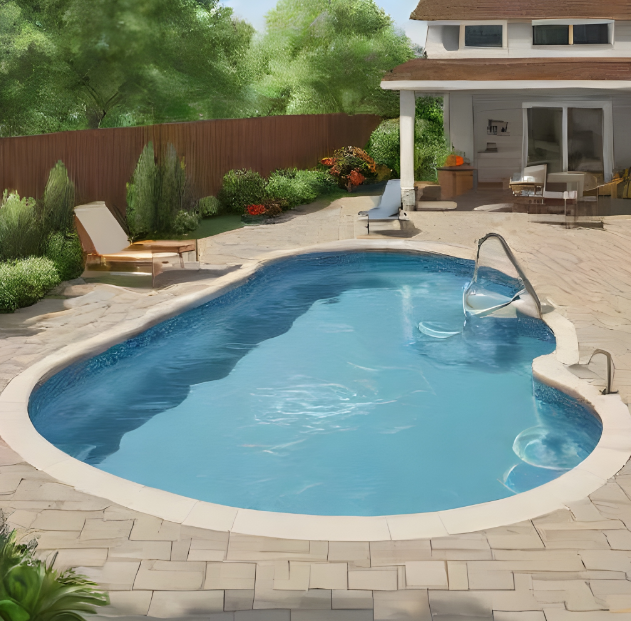
Are you puzzled about the right way to vacuum your pool? Look no further! Whether you’re a pool pro or a newbie, understanding the nuances of backwash and waste is crucial for crystal-clear water.
In this ultimate guide, we’ll demystify the process, offering simple yet effective tips to keep your pool pristine. Get ready to dive in and master the art of pool maintenance!
In this post we will cover:
- Do You Vacuum a Pool on Backwash or Waste?
- How and when do you backwash a sand filter?
- How do you vacuum to waste with a cartridge filter?
- How do you clean a pool that has been sitting?
Do You Vacuum a Pool on Backwash or Waste?
Vacuuming a Pool on Backwash
The backwash method is one of the most active settings on a pool filter. Backwashing sanitizes the sand in your pool’s filtration system after vacuuming your pool almost immediately. The backwash setting is used to reverse the flow in the filter and send water out of the waste line.
When using the backwash setting, ensure that the valves are open and that your backwash hose is rolled out. Backwashing is done when the filter pressure in your pool rises to 8–10 psi over the clean starting pressure. That is approximately 20–24 psi depending on the system that you have.
Below is a step-by-step procedure on how to backwash and vacuum a pool on backwash:
How to backwash
Step 1: Turn off your pool’s pump and then rotate the multiport valve to backwash. Avoid turning the filter valve when the pump is running.
Step 2: Turn on the pump so that the dirty water in the pool can flow out through the waste line. Then turn off the pump once the water runs clear in the sight glass of the valve.
Step 3: Rotate the valve to rinse, and then turn on the pump for about 10 to 20 seconds to clean out the filter head.
Step 4: Switch off the pump and rotate the valve to the filter position. Allow the sand in the filter to settle for one minute while you clean out the pump basket.
Step 5. Turn the pump on and continue filtering. Take a reading of the new clean starting pressure to use as a reference for the next backwash.
Step 6: You may need to inspect and possibly change the sand if the pressure of the filter does not reduce after backwashing. You may also need to add water to your pool to replace the backwashed one.
How to vacuum on backwash
Step 1: Begin by inserting the vacuum hose into your pool and positioning the vacuum plate on top of the skimmer but not in the water.
Step 2: To fill the hose with water, place the vacuum head over a return. When water begins to flow out of the skimmer’s end, push the vacuum plate to the top of the skimmer basket.
Step 3: To receive maximum suction close all valves except for the skimmer valve being used.
Step 4: Begin vacuuming and start with the deeper end coming to the shallow one.
Step 6: Check the pressure now and then so that you know when to backwash. Also, empty the skimmer basket when checking the pressure or whenever you vacuum leaves from your pool.
Step 7: When you’re finished vacuuming, open the valves and remove the vacuum.
Vacuuming a Pool on Waste
The waste setting on a pool’s filtration system serves a crucial role in maintaining optimal cleanliness. It allows for the direct transfer of pool water to the waste channel, bypassing the filter, which is essential for removing heavy debris and contaminants.
This setting is particularly useful during vacuuming to waste, a process vital for eliminating dirt, algae, and microscopic particles that evade regular filtration.
Vacuuming to waste is achievable with multi-port valve-controlled filter systems, commonly found in sand filters. By ejecting debris directly out of the waste hose, it prevents recontamination of the pool.
Necessary equipment includes a vacuum head, hose, telescopic pole, and skim vac. Proper utilization of the waste setting ensures efficient pool maintenance, preventing clogging and ensuring maximum hygiene.
Here’s a step-by-step guide to vacuuming waste:
Step 1: Start by shutting off the pump and then positioning the multiport flap on top of the waste setting.
Step 2: Switch the pump on and by now, all the water in the pool will flow to the sewer.
Step 3: Shut all the skimmer lines down, leaving only one. Then, reduce the main drain to half its capacity.
Step 4: Reset your pool vacuum to its usual regular vacuuming. That involves connecting the pole and swivel end of your vacuum hose to the vacuum head.
Then slowly lower the head into the water. Completely fill the vacuum hose with water and connect the other head to the skimmer plate.
Step 5: Connect your garden hose pipe after un-wrinkling it to the skimmer to which you connected your vacuum hose pipe and then switch the water on.
Step 6: Then vacuum the swimming pool. If your pool has a deep end, begging vacuuming from there. While vacuuming, keep an eye on the water level because if you allow it to get too low, it will cause your pump to run dry, which can cause serious damage.
Step 7: Close the skimmer and the skimmer flap that you recently vacuumed, and then unleash the main drain flap all the way.
Step 8: Return the multiport valve to the filtration system and switch on the pump. You are now removing water from the pool’s main channel while all of your skimmers are turned off.
Step 9: When the pump has achieved its goal of lowering the main channel valve by 50%, fully open the skimmer flap.
FAQs
How and when do you backwash a sand filter?
Maintaining a clean pool involves periodic backwashing of the sand filter, indicated by a pressure gauge reading 8-10 lbs above the clean starting pressure. This process flushes out accumulated dirt and debris by reversing the water flow through the filter.
A multiport valve or a slide valve facilitates this operation, with six or two positions respectively. Before initiating backwashing, ensure the filter pump is turned off to prevent damage.
Following backwashing, pool water flows from bottom to top, expelling impurities through the waste line. This essential maintenance step ensures optimal filtration efficiency, promoting clear and inviting pool water for enjoyment.
How do you vacuum to waste with a cartridge filter?
Vacuuming to waste is a method used in pool maintenance to bypass the filter and expel water directly out of the system. While sand filters typically have a dedicated valve for this purpose, cartridge filters require alternative approaches.
One method involves removing the filter lid and securely replacing it after connecting a hose adapter. Another option is to install a third-way valve between the filter and pump, allowing for easy redirection of water flow.
Both techniques ensure efficient waste removal without compromising the filtration system’s integrity, providing flexibility and convenience for pool owners of all levels of expertise.
How do you clean a pool that has been sitting?
Reviving a neglected pool demands strategic care. For vinyl or fiberglass pools, avoid draining as it can harm their structure. Instead, utilize a trash pump to swiftly rid debris. Opt for a gas pump for lighter cleaning.
Post-drain, consider acid or pressure washing for optimal results, using mild soap and low pressure for delicate materials. Alternatively, employ leaf nets and baggers to eliminate organic debris. Balance pH levels post-cleaning and shock the pool for purification.
Utilize flocculant or clarifier for particle settlement, then vacuum and refill the pool for a refreshed sparkle. Choose the method aligning with your pool type for a seamless revival.
The Wind-Up
So, next time you’re wondering whether to vacuum your pool on backwash or waste, remember the importance of water conservation and maintaining your pool’s cleanliness. By following the right steps, you can keep your pool crystal clear while being mindful of the environment. Don’t hesitate to reach out to professionals if you need further guidance. Happy swimming and happy pool maintenance

